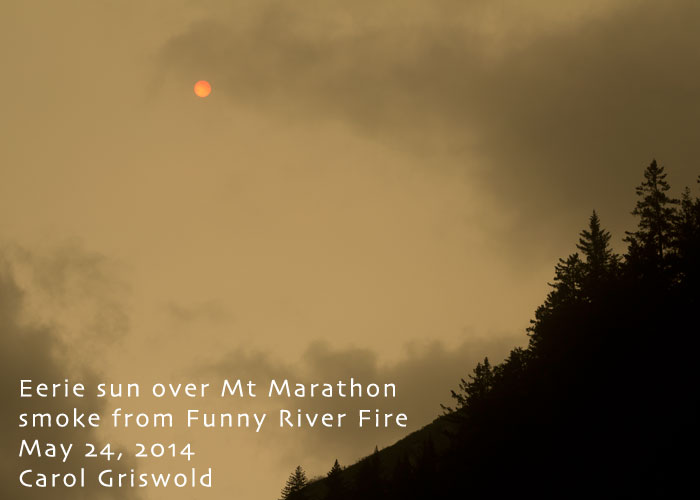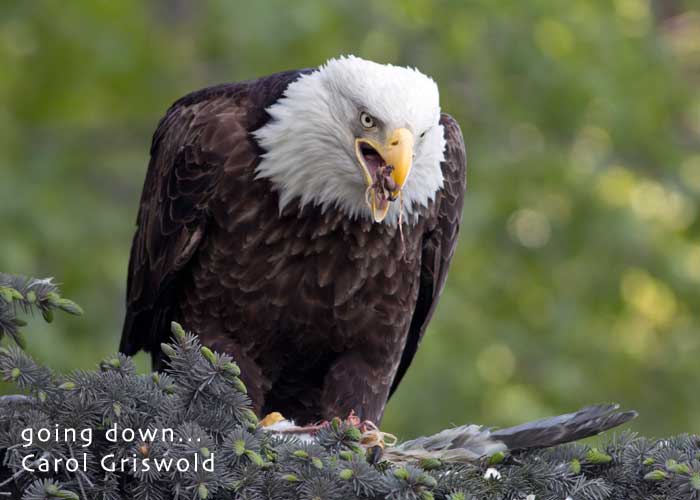Sunrise 4:55 am, sunset 10:55
pm for a total day length of 18 hours. Tomorrow will be 3 minutes and 49
seconds longer. Sunshine continued today with cooler temperatures up to the mid
50s, and a brisk 17 mph south wind with gusts to 23 mph. The month-long drought
is forecast to end tomorrow with rain likely through to the weekend. Dark gray, promising clouds are on
their way from the Gulf of Alaska this evening. We really need the rain!
Even more critically, rain is
needed to help control the massive Funny River fire in central Kenai Peninsula.
That wildfire has now burned over 176,000 acres (275 square miles) near
Sterling, Soldotna, and Kasilof in the Kenai National Wildlife Refuge. It is
the second largest fire in the 72-year history of the refuge; the Skilak Lake
fire burned 310,000 acres in 1947. The impacts on the nesting birds of the
boreal forest are yet to be considered and understood, but it is a tremendous
loss.
Seward has been mostly spared
from the impacts of the fire, with only a few days of hazy, yellowish skies and
the faint smell of smoke. Saturday evening, however, as the wildfire blazed in
intensity west of the Harding Icefield, the light turned a bright yellow hue. I
felt like I was wearing my new amber sunglasses and checked, but I wasn't. The
round disk of the sun was actually visible, looking surprisingly smaller than
the moon, and at times glowed an eerie vampire red. It was an incredible
phenomenon.
While the wildfire raged and
hundreds of firefighters and homeowners toiled to save their homes, life
continued normally in Seward. This morning, I joined visitors from all over the
world to enjoy the beautiful green spring unfolding at Exit Glacier, part of
Kenai Fjords National Park.
ORANGE-CROWNED,
YELLOW-RUMPED, and WILSON'S WARBLERS trilled from the fragrant cottonwood
trees. VIOLET-GREEN SWALLOWS swooped over the glacier and outwash plain,
seeking recently emerged insects. A COMMON REDPOLL hunted for insects along the
glacier trail. Many HERMIT THRUSHES, aka "woodland flutes," declared
their territories from high perches, tossing their cascading notes across the
landscape. A VARIED THRUSH blew his referee whistle in the distance while a
ROBIN clucked; no "cheerio" for him today.
Exit Glacier is a great place
for thrushes. I did not yet hear either the Swainson's or Gray-cheeked
Thrushes, but it is still early for some species which makes it fun to visit
every few days to check.
Later in the afternoon, I
drove out to Lowell Point. A BALD EAGLE flew right overhead, quite low,
hunting. As many times as I have seen this, I am always in awe of their power and
size. While driving back, I spotted a RAVEN flying at top speed above the road,
heckling a Bald Eagle that was carrying something dangling in its talons. The
Raven shot on past when the Eagle abruptly landed in a spruce tree next to the
road. A small traffic jam ensued as people spotted the spectacle and stopped. I
pulled over as well to watch the eagle dine.
It appeared to be a gull
carcass that had already been mostly consumed, definitely missing all the
choice parts. Maybe the raven convinced the eagle to move along before he was
finished, or maybe the eagle scavenged it and found it worthy of a closer look.
Regardless, the eagle seemed famished and tore off bits of meat, gristle, and
sinew with gusto and gobbled them down. I was amazed to watch him pick up a meatless
femur, and much like a gull, work it around to align with his throat, and
swallow it. It wasn't easy, but down it went. What a gizzard these birds have,
to digest such a large bone!
It was also interesting to
see the third eyelid, the nictitating membrane. The eagle closed it often,
covering its fierce yellow eyes with this pale blue shutter, instantly transforming
his face. The membrane originated from the front and slid backwards, instead of
from the top or bottom. Pretty
amazing.
The action slowed down after
a patch of feathers was plucked and shucked to the wind, and a few more bones
were nibbled. I don't think there was much left worth eating. I left him
sitting there on top of the pile of feathers and bones, peering at the
blue-green, white-capped bay, searching for a more substantial dinner.
From tiny warblers to mighty
eagles, there's always something worth watching, hearing, and learning in the bird world.
Happy Birding!
Carol Griswold
Seward Sporadic Bird Report
Reporter
Hi Ann!















No comments:
Post a Comment